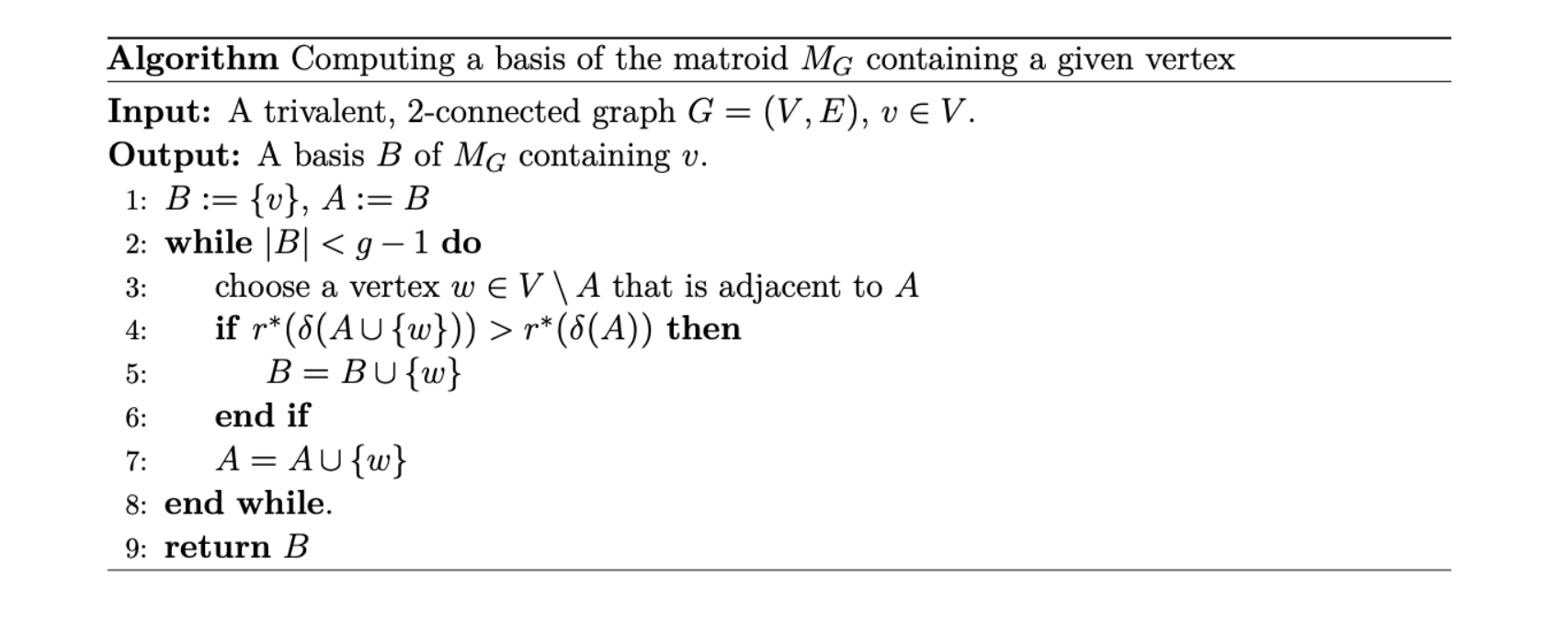Graph Curve Matroids
Macaulay2.Constructing the graph curve matroid
We have implemented the algorithm for computing the graph curve matroid of any given graph in Macaulay2. The code can be downloaded here graphCurveMatroid.m2.
Please note that this code only works for simple graphs, as \(\texttt{Macaulay2}\) does not work with parallel edges in graphs. However, one can still construct the graph curve matroid of a non-simple graph, but the code needs some adaptation. The main functionalities that need modification are the computation of the cycle matroid, which works for graphs with loops but without parallel edges, and the computation of the set of incident edges \(\delta(A)\) for a vertex set \(A\), which in the above code is implemented only for simple graphs.
Here is an example how to use the code in
Macaulay2for a simple graph:
value get "graphCurveMatroid.m2";
G = graph({{1, 2}, {2, 3}, {3, 1}, {3, 5}, {4, 5}, {4, 2}, {5, 7}, {6, 7}, {6, 4}, {7, 8}, {8, 6}, {1, 8}}, EntryMode => "edges");
M = graphCurveMatroid G;
M == dual(M)
true
rank M
4
#bases M
54
#circuits M
26

The figure displays the double house graph from Figure 2 in the paper with the labeling as used to make the graph \(\texttt{G}\) in the code example. So the corresponding graph curve matroid for the double house graph is identically self-dual of rank 4, has 54 bases and 26 circuits.
Runtime of the algorithm

The runtime of the algorithm to compute the graph curve matroid grows exponentially with the number of vertices of the graph. For example, the computation of a graph curve matroid of a trivalent graph with 14 vertices takes already 1673.56 seconds.
Graphs and their graph curve matroids
The data on trivalent (also called cubic) simple graphs originated here https://houseofgraphs.org/meta-directory/cubic.
Below, we provide the edge sets for trivalent simple graphs with up to 12 vertices and files with the bases of the associated graph curve matroids in a Macaulay2 readable format.
Graphs
Graph Curve Matroids
How to use the files: The graph arising from the edges in the ith entry of the list in graphs_04vertices.txt gives rise to the graph curve matroid given by the set of bases stored in the ith entry of the list in matroids_graphs_04vertices.txt.
value get "graphCurveMatroid.m2";
GraphsList = value get "graphs_06vertices.txt";
#GraphsList
2
G = graph(GraphsList#0, EntryMode =>"edges"); --build a graph from the first list of edges
MatroidsList = value get "matroids_graphs_06vertices.txt";
M = matroid({0,1,2,3,4,5}, MatroidsList#0, EntryMode => "bases") --build a matroid from the list of bases
M == graphCurveMatroid G;
true
Constructing a basis
Given a trivalent, 2-connected graph \(G\) and a vertex \(v\), the proof of Proposition 4.3 provides a constructive way to directly create a basis of \(M_G\) containing \(v\) without computing the whole matroid \(M_G\) first. Correctness follows from Lemmas 4.1 and 4.2.

We implemented this algorithm in Macaulay2. Our code can be downloaded here: basis-construction.m2. The code asks the user to input a graph (in a Macaulay2-readable format) and a vertex, and outputs to the user a basis of the associated graph curve matroid containing the given vertex.
value get "basis-construction.m2"
Graph: graph({{1, 2}, {2, 3}, {3, 1}, {3, 5}, {4, 5}, {4, 2}, {5, 7}, {6, 7}, {6, 4}, {7, 8}, {8, 6}, {1, 8}}, EntryMode => "edges")
vertex: 3
set {1, 3, 5, 7}
Project page created: 08/11/2023
Project contributors: Alheydis Geiger, Kevin Kühn, and Raluca Vlad
Corresponding author of this page: Alheydis Geiger, geiger@mis.mpg.de
Code written by: Alheydis Geiger and Raluca Vlad
Software used: Macaulay2 (v1.19.1)
System setup used: MacBook Pro with macOS 12.7, Processor 2,6 GHz Quad-Core Intel Core i7, Memory 16 GB, Graphics Intel HD Graphics 530.
License for code of this project page: MIT License (https://spdx.org/licenses/MIT.html)
License for all other content of this project page (text, images, …): CC BY 4.0 (https://creativecommons.org/licenses/by/4.0/)
Last updated 09/07/2024.